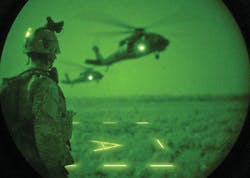Electro-optical sensor designers shrinking infrared pixel size to enhance resolution
BALTIMORE - Cooled and uncooled infrared sensor image resolution is improving, as electro-optical pixel size is shrinking from 17 microns to 12 microns, say experts at SOFRADIR in Palaiseau, France. Smaller pixel size not only means better infrared image resolution, but also longer range and potentially smaller size and weight because of reduced need for sensor cooling, says Philippe Bensussan, the SOFRADIR chairman and CEO.
Infrared sensors are important imaging sources on platforms ranging from orbiting satellites to soldier rifle sights, and everything in-between. They play key roles in applications like military night vision, structure fire detection, missile guidance, and enhanced vision systems.
Infrared sensors in the most demanding applications typically use cooling. Long-wave infrared relies on detecting the differences between temperatures of objects in its field of view. Cooling heightens that ability, but also increases system size, weight, power consumption, and cost.
Enhanced resolution could enable designers to build smaller infrared sensors for use in rifle sights, handheld sensors, body-worn detectors, and a wider variety of unmanned vehicles. Smaller pixel size offers the potential to use several sensors in a system, which can enable new capabilities like wide-field-of-view surveillance that stitches together imagery from multiple sensors.
Enhanced resolution also has the potential to reduce system power consumption, which has a direct influence on battery-powered systems. Less power means fewer batteries, which is good news for any infantry warfighter who has to go on patrol with a heavy load.
Think again about cooling. Enhanced sensor resolution also could reduce or eliminate the need for sensor cooling, which can reduce system complexity, size, weight, and cost, as well as enhance reliability.
As for the transition from 17-micron to 12-micron pixels in infrared sensors, SOFRADIR's Bensussan says his company is in the research-and-development stage now, with prototype systems in test and demonstration. The company will take this technology to market sometime next year, he says.
FOR MORE INFORMATION visit SOFRA-DIR online at www.sofradir.com.

John Keller | Editor
John Keller is editor-in-chief of Military & Aerospace Electronics magazine, which provides extensive coverage and analysis of enabling electronic and optoelectronic technologies in military, space, and commercial aviation applications. A member of the Military & Aerospace Electronics staff since the magazine's founding in 1989, Mr. Keller took over as chief editor in 1995.

